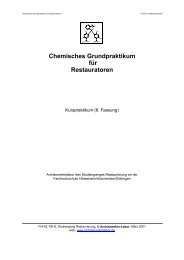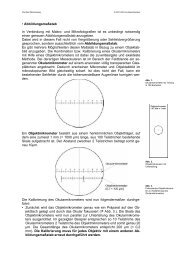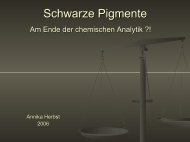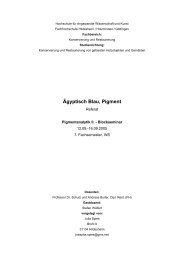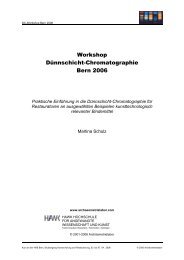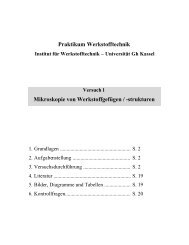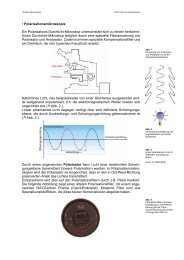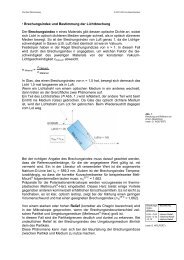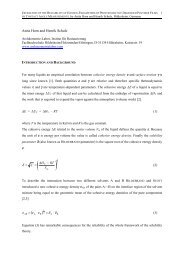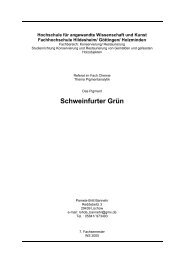Henrik Schulz* and Anita Horn, Archäomertrie-Labor der HAWK ...
Henrik Schulz* and Anita Horn, Archäomertrie-Labor der HAWK ...
Henrik Schulz* and Anita Horn, Archäomertrie-Labor der HAWK ...
You also want an ePaper? Increase the reach of your titles
YUMPU automatically turns print PDFs into web optimized ePapers that Google loves.
Manuscript, H. Schulz <strong>and</strong> A. <strong>Horn</strong>, Hildesheim, henrik.schulz@archaeometrielabor.com 3<br />
process of the activated surface energy? At first we will consi<strong>der</strong> the situation of a real<br />
wooden surface un<strong>der</strong> normal atmosphere of moist air. A certain number of water molecules<br />
from the gaseous phase will be adsorbed at the surface <strong>and</strong> be stabilized by mediation of the<br />
hydrogen bonding via the ubiquitous hydroxy groups of the cellulose but as well of the lignin<br />
<strong>and</strong> other resinous compounds. The situation of the adsorption layer at the wooden surface<br />
will be changed vigorously by the impacts of the electrical charged particles of the plasma.<br />
One of the main topics is questioned about the number of adsorbed molecules at the<br />
interfacial region <strong>and</strong> the change of that quantity after the plasma treatment. A change in<br />
adsorption is always accompanied by a change of energy, in particular the change of the<br />
surface free energy ∆G or in relation to the change of a specific area ∆A the interfacial tension<br />
γ:<br />
∆G<br />
γ =<br />
∆A<br />
(1)<br />
An easy way to study such changes at the surface of solids by experiments is the so-called<br />
wetting procedure. The wetting of a surface by a liquid <strong>and</strong> their final extent of spreading is<br />
very simple but covers a lot of information about the real surface. Figure 2 exhibits the<br />
classical three-phase situation of two immiscible fluids 1 <strong>and</strong> 2 in contact with a plane surface<br />
of the solid S. Furthermore the fluid 1 is called the “inner fluid” <strong>and</strong> fluid 2 the “outer fluid”.<br />
Figure 2 The force equilibrium at the point of the coexistence of the three phases to<br />
<strong>der</strong>ive the classical YOUNG´s equation (2) [8]<br />
In the classical way the three depicted arrows symbolise the three forces related to γ12, γS1 <strong>and</strong><br />
γS2. All three forces start at the triple point, i.e. where all of the phases co-exist simultaneously<br />
in equilibrium. The directions of γS1 <strong>and</strong> γS2 are opposite but parallel to the surface of the<br />
solid. γ12 <strong>and</strong> γS1 encircle the so-called contact angle Θ. If we consi<strong>der</strong> the force balance the<br />
YOUNG´s equation (2) straight follows as:<br />
γ12⋅cos Θ + γS1 = γS2 (2)



